QB50 CubeSats successful by PSLV-C38

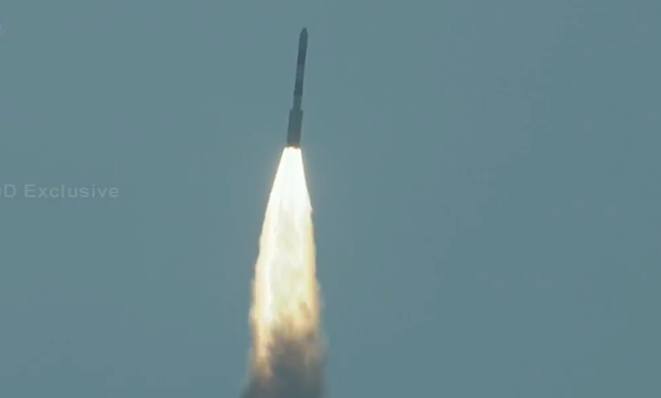 (C)ISRO
Other satellites launched Friday include a spacecraft named CESat-1 from
Japan designed to demonstrate Earth observations using Canon imaging
technology. The Max Valier Satellite, with an X-ray astronomy telescope
and an amateur radio beacon, was developed in partnership by Italian high
school students, Germany's OHB System AG satellite contractor, and the
Max Planck Institute for Extraterrestrial Physics.
Latvia's first satellite, named Venta-1, hosts digital cameras and a ship
tracking instrument. The 16.5-pound (7.5-kilogram) satellite was built by
Latvian students and funded by the Latvian government.
Eight CubeSats for the multi-national QB50 science consortium, formed by
educational institutions to conduct a wide range of research in low Earth
orbit, also headed into space Friday.
The QB50 CubeSats launched from India are the second batch of satellites
to lift off, following 28 of the compact student-built platforms which
launched in April on an Atlas 5 rocket going to the ISS.
The QB50 CubeSats launched Friday include:
Pegasus from the University of Applied Sciences Wiener Neustadt
in Austria
NUDTSat from the National University of Defense Technology
in China
VZLUSAT-1 from universities and institutions in the Czech Republic
COMPASS-2 (DragSail-CubeSat) from the FH Aachen University of
Applied Sciences in Germany
UCLSat from University College London in the United Kingdom
InflateSail from the University of Surrey in the United Kingdom
URSA MAIOR from the Sapienza University of Rome in Italy
LituanicaSAT-2 from Vilnius University in Lithuania
Other payloads aboard the PSLV included the SUCHAI 1 CubeSat developed
by students and faculty at the University of Chile in Santiago.
It carries instrumentation to study the environment in low Earth orbit.
The Aalto-1 CubeSat built by Finnish university students will test a new
type of spectrometer in space, measure space radiation and demonstrate an
electrostatic plasma brake to drop out of orbit at the end of its mission.
Sponsored by the European Space Agency, the Robusta-1B CubeSat from
the University of Montpellier 2 in France will measure the effects of
radiation on satellite electronics.
(C)Spaceflight Now
QB50 CubeSats update, 23 June 2017
InflateSail, NIUSAT, NUDTSat, UCLSat, URSA MAIOR, etc.
(C)JA0CAW (C)PY4ZBZ
(C)ISRO
Other satellites launched Friday include a spacecraft named CESat-1 from
Japan designed to demonstrate Earth observations using Canon imaging
technology. The Max Valier Satellite, with an X-ray astronomy telescope
and an amateur radio beacon, was developed in partnership by Italian high
school students, Germany's OHB System AG satellite contractor, and the
Max Planck Institute for Extraterrestrial Physics.
Latvia's first satellite, named Venta-1, hosts digital cameras and a ship
tracking instrument. The 16.5-pound (7.5-kilogram) satellite was built by
Latvian students and funded by the Latvian government.
Eight CubeSats for the multi-national QB50 science consortium, formed by
educational institutions to conduct a wide range of research in low Earth
orbit, also headed into space Friday.
The QB50 CubeSats launched from India are the second batch of satellites
to lift off, following 28 of the compact student-built platforms which
launched in April on an Atlas 5 rocket going to the ISS.
The QB50 CubeSats launched Friday include:
Pegasus from the University of Applied Sciences Wiener Neustadt
in Austria
NUDTSat from the National University of Defense Technology
in China
VZLUSAT-1 from universities and institutions in the Czech Republic
COMPASS-2 (DragSail-CubeSat) from the FH Aachen University of
Applied Sciences in Germany
UCLSat from University College London in the United Kingdom
InflateSail from the University of Surrey in the United Kingdom
URSA MAIOR from the Sapienza University of Rome in Italy
LituanicaSAT-2 from Vilnius University in Lithuania
Other payloads aboard the PSLV included the SUCHAI 1 CubeSat developed
by students and faculty at the University of Chile in Santiago.
It carries instrumentation to study the environment in low Earth orbit.
The Aalto-1 CubeSat built by Finnish university students will test a new
type of spectrometer in space, measure space radiation and demonstrate an
electrostatic plasma brake to drop out of orbit at the end of its mission.
Sponsored by the European Space Agency, the Robusta-1B CubeSat from
the University of Montpellier 2 in France will measure the effects of
radiation on satellite electronics.
(C)Spaceflight Now
QB50 CubeSats update, 23 June 2017
InflateSail, NIUSAT, NUDTSat, UCLSat, URSA MAIOR, etc.
(C)JA0CAW (C)PY4ZBZ
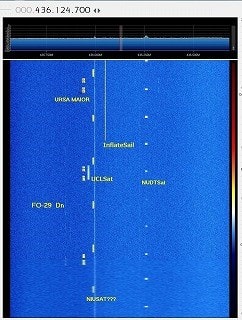
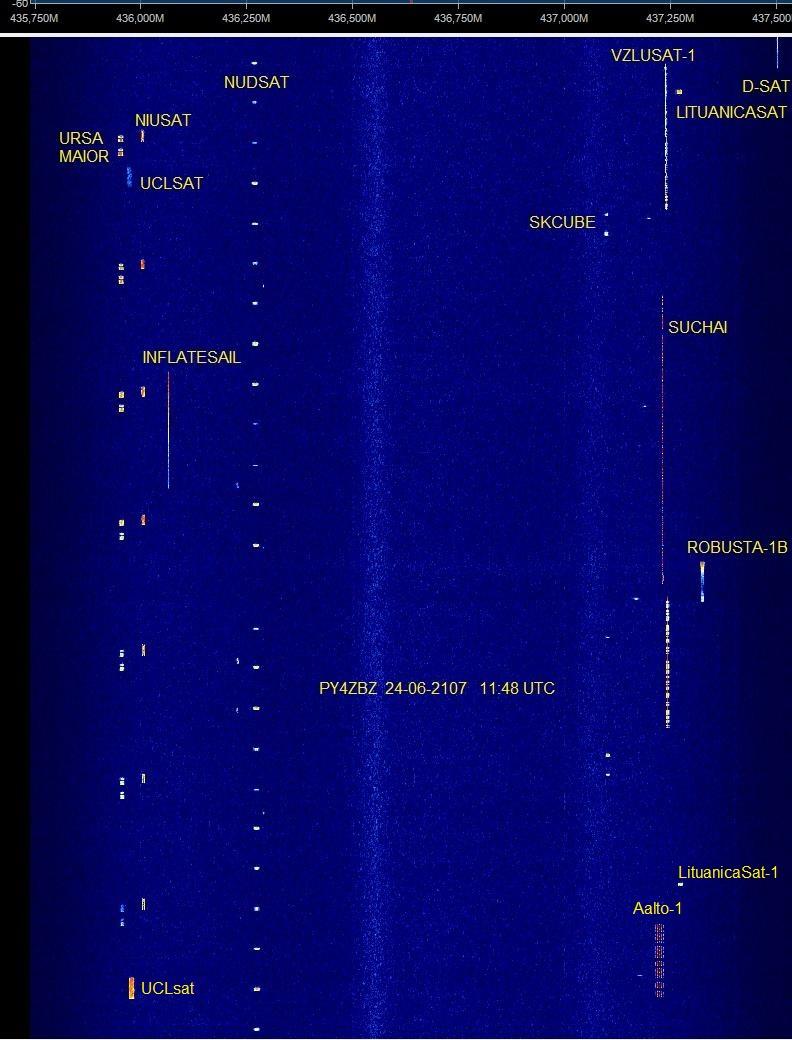 (C)Daniel
(C)Daniel
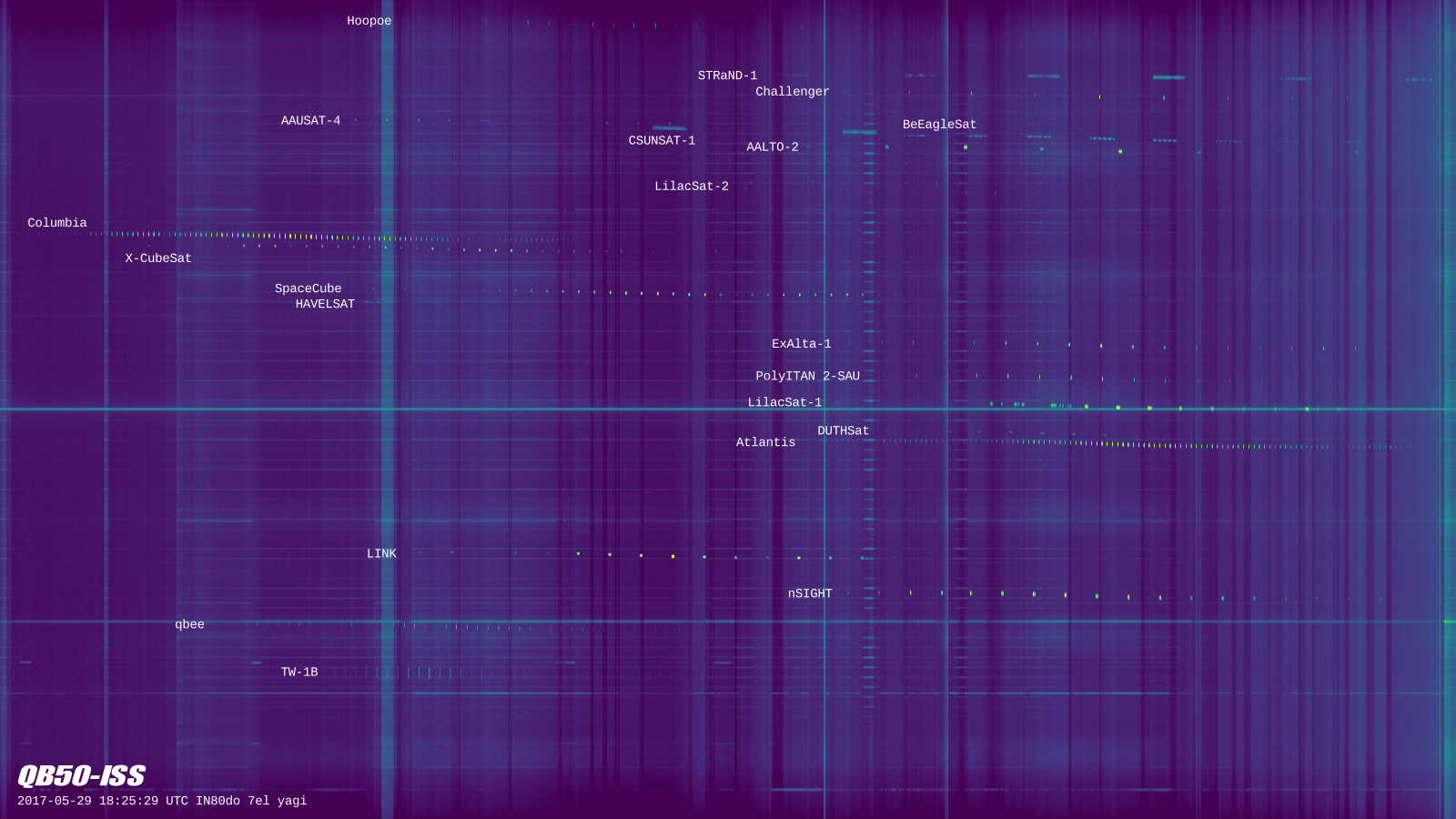 PEGASUS 436.670 MHz 9k6 FSK heard
NUDTSat 436.270 MHz 9k6 BPSK heard
VZLUSAT-1 437.240 MHz CW heard
DRAGSAIL (Compass-2) 437.300 MHz 1k2 AFSK not heard
UCLSAT 435.975 MHz 9k6 FSK heard
INFLATESAIL 436.060 MHz 1k2 BPSK heard
URSA MAIOR 435.950 MHz 9k6 FSK heard
LITUANICASAT-2 437.265 MHz 9k6 FSK heard
SUCHAI 437.225 MHz CW heard
ROBUSTA-1B 437.325 MHz CW heard
SKCube 437.100 MHz 9k6 FSK heard
D-SAT 437.505 MHz 4k8 GMSK heard
Max Valier Sat 145.960 MHz CW heard
NIUSAT 436.000 MHz 1k2 FSK heard
LATVIA 436.325 MHz 9k6 FSK heard
(C)DK3WN
PEGASUS 436.670 MHz 9k6 FSK heard
NUDTSat 436.270 MHz 9k6 BPSK heard
VZLUSAT-1 437.240 MHz CW heard
DRAGSAIL (Compass-2) 437.300 MHz 1k2 AFSK not heard
UCLSAT 435.975 MHz 9k6 FSK heard
INFLATESAIL 436.060 MHz 1k2 BPSK heard
URSA MAIOR 435.950 MHz 9k6 FSK heard
LITUANICASAT-2 437.265 MHz 9k6 FSK heard
SUCHAI 437.225 MHz CW heard
ROBUSTA-1B 437.325 MHz CW heard
SKCube 437.100 MHz 9k6 FSK heard
D-SAT 437.505 MHz 4k8 GMSK heard
Max Valier Sat 145.960 MHz CW heard
NIUSAT 436.000 MHz 1k2 FSK heard
LATVIA 436.325 MHz 9k6 FSK heard
(C)DK3WN
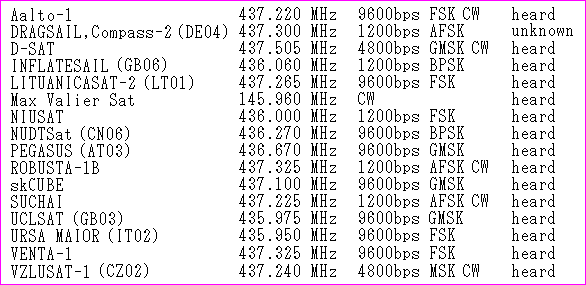 (C)JE9PEL
(C)JE9PEL
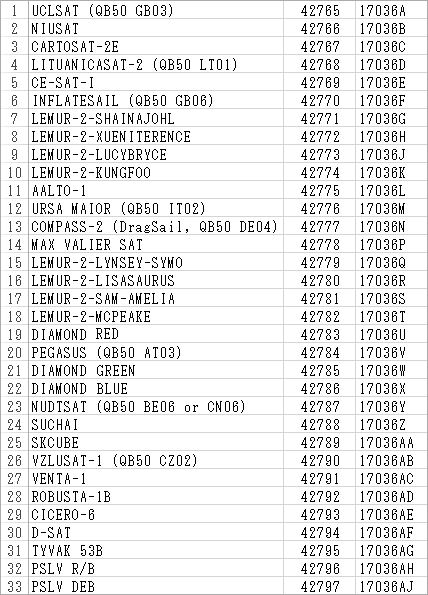 (C)DK3WN (C)PE0SAT (E)JE9PEL
(C)DK3WN (C)PE0SAT (E)JE9PEL
 Back to Top
Back to Top
 Back to Home Page
Back to Home Page


(C)ISRO Other satellites launched Friday include a spacecraft named CESat-1 from Japan designed to demonstrate Earth observations using Canon imaging technology. The Max Valier Satellite, with an X-ray astronomy telescope and an amateur radio beacon, was developed in partnership by Italian high school students, Germany's OHB System AG satellite contractor, and the Max Planck Institute for Extraterrestrial Physics. Latvia's first satellite, named Venta-1, hosts digital cameras and a ship tracking instrument. The 16.5-pound (7.5-kilogram) satellite was built by Latvian students and funded by the Latvian government. Eight CubeSats for the multi-national QB50 science consortium, formed by educational institutions to conduct a wide range of research in low Earth orbit, also headed into space Friday. The QB50 CubeSats launched from India are the second batch of satellites to lift off, following 28 of the compact student-built platforms which launched in April on an Atlas 5 rocket going to the ISS. The QB50 CubeSats launched Friday include: Pegasus from the University of Applied Sciences Wiener Neustadt in Austria NUDTSat from the National University of Defense Technology in China VZLUSAT-1 from universities and institutions in the Czech Republic COMPASS-2 (DragSail-CubeSat) from the FH Aachen University of Applied Sciences in Germany UCLSat from University College London in the United Kingdom InflateSail from the University of Surrey in the United Kingdom URSA MAIOR from the Sapienza University of Rome in Italy LituanicaSAT-2 from Vilnius University in Lithuania Other payloads aboard the PSLV included the SUCHAI 1 CubeSat developed by students and faculty at the University of Chile in Santiago. It carries instrumentation to study the environment in low Earth orbit. The Aalto-1 CubeSat built by Finnish university students will test a new type of spectrometer in space, measure space radiation and demonstrate an electrostatic plasma brake to drop out of orbit at the end of its mission. Sponsored by the European Space Agency, the Robusta-1B CubeSat from the University of Montpellier 2 in France will measure the effects of radiation on satellite electronics. (C)Spaceflight Now QB50 CubeSats update, 23 June 2017 InflateSail, NIUSAT, NUDTSat, UCLSat, URSA MAIOR, etc. (C)JA0CAW (C)PY4ZBZ

(C)Daniel
PEGASUS 436.670 MHz 9k6 FSK heard NUDTSat 436.270 MHz 9k6 BPSK heard VZLUSAT-1 437.240 MHz CW heard DRAGSAIL (Compass-2) 437.300 MHz 1k2 AFSK not heard UCLSAT 435.975 MHz 9k6 FSK heard INFLATESAIL 436.060 MHz 1k2 BPSK heard URSA MAIOR 435.950 MHz 9k6 FSK heard LITUANICASAT-2 437.265 MHz 9k6 FSK heard SUCHAI 437.225 MHz CW heard ROBUSTA-1B 437.325 MHz CW heard SKCube 437.100 MHz 9k6 FSK heard D-SAT 437.505 MHz 4k8 GMSK heard Max Valier Sat 145.960 MHz CW heard NIUSAT 436.000 MHz 1k2 FSK heard LATVIA 436.325 MHz 9k6 FSK heard (C)DK3WN
(C)JE9PEL
(C)DK3WN (C)PE0SAT (E)JE9PEL